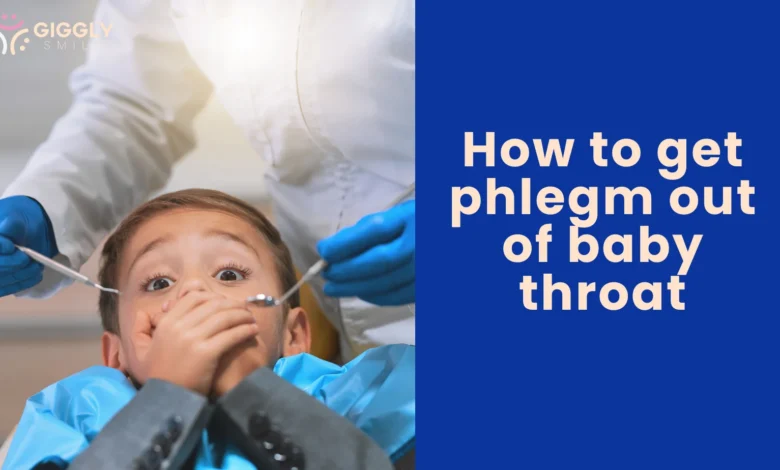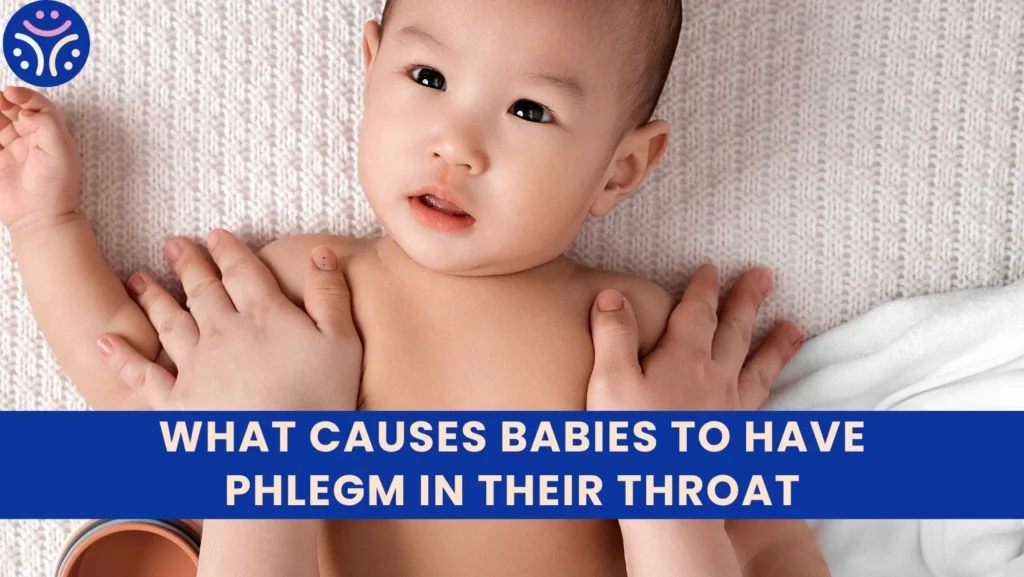
How to get phlegm out of baby throat?
Here we discuss about the techniques and causes of how to get phlegm out of baby throat. Excess phlegm in babies’ throats can cause pain and trouble breathing, eating, or sleeping. Phlegm, which is usually caused by respiratory infections or allergies, can build up in the baby’s throat, causing congestion and potentially serious respiratory difficulties.
As a caregiver, you must understand safe and effective techniques to assist your baby eliminate phlegm from their throat, which will relieve their pain and encourage healthier breathing.
This tutorial will show you some easy strategies how to get phlegm from baby throat, guaranteeing their comfort and well-being. However, if you are concerned about your baby’s health, or if the phlegm remains or worsens, you should see a physician.
How to Help Clear Phlegm from Your Baby’s Throat

Parents get quite concerned when their newborn develops phlegm in the throat, but there are very few medications that can be given to babies when they are not sick. Applying some of the following techniques will help you quickly clear your throat and get rid of sputum:
Here’s a more extensive instruction to removing mucus from your baby’s throat:
Adequately Hydrated
Pour in enough water for the baby. You can feed your kid many times if they are under six months old and are solely breastfed.
Children who are older than six months should consume more water each day, whether it is during the day or during playtime. Because a body that is adequately hydrated will have thinner mucus, which will be simpler for the baby to expel through coughing and sneezing.
Using a nasal aspirator to extract sputum The youngster will feel uncomfortable and irritable when phlegm builds up in the throat, and they may also experience consequences from pneumonia or otitis media.
Therefore, you can use safe instruments like a rubber suction bulb, a soft wire nasal aspirator, or a nasal aspirator to remove phlegm from your baby’s nasopharynx.
Keep in mind that while using these instruments on children, they must always be cleansed before use and maintained clean to prevent infection. Each youngster should use it in a separate container to prevent cross-contamination.
Physiological saline in each nostril
You can thin the child’s sputum by putting a few drops of physiological saline in each nostril before you start sucking. Raise the babies head a little when sucking on their nose to prevent choking, and suck on both sides. Nasal suction can be repeated two or three times a day.
Normal saline droplets For newborns and early children, physiological saline aids with nose and throat disinfection in addition to thinning sputum to facilitate nasal aspiration.
After placing two to three drops in each nostril, raise the baby to a standing posture to allow the mucus to freely flow out pulsating towards kids. Children can be encouraged to cough out phlegm by using a vibrating device to aid in mucus expulsion.
Clear the baby’s airways of the phlegm
The baby should be positioned so you may pat his or her back. To help clear the baby’s airways of the phlegm, you cupped your hand and gave him a gentle smack on the back. Keep in mind that you should only pat the child’s lungs; do not touch their spine or abdomen.
Verify if the surroundings are tidy. To reduce the likelihood that the illness may return in children, keep them away from dust, mold, cigarette smoke, and other allergens.
Clean blankets, pillows, kids’ clothing, and other household objects on a regular basis, particularly the carpets, which are a breeding ground for bacteria that can cause illness.
Removing and cleaning the agent will help lower the baby’s chance of being sick with respiratory issues. Apply a few essential oils. Essential oils that help warm a space, clear nasal congestion, and lessen phlegm production include lemongrass and melaleuca.
Essential oils can be used to vaporize the space or applied sparingly to clothing, blankets, and pillows so that your baby can smell it. Keep the young person’s body warm.
A youngster who is chilly is more likely to get sick and create more mucus, which is a good environment for numerous bacteria. Keeping the body warm and avoiding the cold is one strategy to care for a kid who has phlegm in their throat, especially during the winter.
Humidifier or Steam
To keep the air moist in your baby’s room, use a cool mist humidifier. Alternatively, provide a steamy environment by running a hot shower and sitting with your baby in the bathroom for a few minutes. This helps to release mucus and relieve congestion.
Nasal Saline Drops
Place saline nasal drops into your baby’s nostrils. These drops thin the mucus, making it simpler for your baby to eliminate phlegm. Gently tilt your baby’s head back and place a few drops into each nostril. Wait a few seconds before suctioning out the loosened mucus with a bulb syringe.
Nasal Aspirator or Bulb Syringe
Use a nasal aspirator or bulb syringe to suction extra mucus from your baby’s nose. Squeeze the syringe’s bulb, gently place the tip into your baby’s nose, and then release it to suck out the mucus. Repeat the technique with the other nostril. Clean the aspirator or bulb syringe completely after each use.
Positioning
Keep your baby upright or slightly inclined while eating or sleeping to avoid mucus from accumulating in their throats. This can relieve discomfort and help to get phlegm out of baby throat.
Gentle back Patting
Gently pat your baby’s back while keeping them upright to assist dislodge and clear mucus. To encourage mucus ejection, use a cupped palm to touch the upper back between the shoulder blades.
Hydration
If your baby is above six months old, keep them hydrated by feeding breast milk, formula, or water. Hydration thins mucus, making it simpler for your baby to clean their throat.
Elevating the Mattress
If your baby has congestion while sleeping, raise one end of their mattress slightly to assist discharge mucus from the throat. To create a mild inclination, place a rolled towel or blanket under the head end of the mattress.
Warm liquid
Warm drink is also used to help get phlegm out of baby throat, like breast milk, formula, or water might help calm your baby’s throat and eliminate mucus. It might help release mucus and give comfort for your baby.
What causes babies to have phlegm in their throat

A newborn’s resistance has not yet fully formed, it is vulnerable to external stimuli, particularly those affecting the respiratory system. Furthermore, when unwell, the cough reflex remains weak, making it difficult to get phlegm out of baby throat.
Phlegm in newborns’ throats can be caused by a variety of conditions, including:
Nasopharyngitis
Nasopharyngitis in newborns may be caused by allergies, viral agents, bacteria, or viruses. All fungi stimulate the body to produce more nasopharyngeal secretions in order to eradicate infections.
Mucus in the nose creates a runny nose and stuffy nose, and it can flow down the throat, causing the kid to wheeze and cough, or down the lower respiratory tract, resulting in a lower respiratory tract infection.
Bronchitis
Inflammation and increased secretions in the bronchial tree are symptoms of bronchitis. When kids who have bronchitis frequently cough up a lot of phlegm, they have acute dyspnea, fast breathing, and wheezing.
The flu and colds are both brought on by viruses. The viral agents, however, are distinct. Cold symptoms are typically less severe and have a better prognosis. After a cold, children frequently exhibit symptoms including runny or stuffy noses, fever, coughing, and congestion.
Gastroesophageal Reflux
Because the child’s sphincter is not yet fully developed, reflux often occurs when food cannot be digested. When children with this disease often have a lot of cough, vomiting, sore throat mucosa and produce sputum.
Some factors increase the risk of making babies more susceptible to phlegm in the throat, such as: cold, environment with a lot of cigarette smoke, pollution, too dry weather, changes in weather.
Conclusion
Gentle and supportive steps are needed to assist your baby rid their throat of phlegm and encourage improved breathing. You may help your baby release extra mucus by using techniques like humidifiers, nasal saline drops, nasal aspirators, and keeping correct posture.
Keeping yourself properly hydrated, providing warm beverages, and raising the mattress can all help your baby feel more comfortable and help eliminate mucus. However, if the phlegm continues or gets worse, or if you have worries about your baby’s health, you should definitely see your physician.
As your baby recovers from respiratory congestion, you can help them breathe more easily and feel more comfortable.
Frequently Asked Questions
How can I tell if my child has a sore throat?
A newborn with phlegm in their throat may experience breathing difficulties, nasal congestion, coughing, gurgling sounds, and feeding issues. Additionally, your baby can seem agitated or restless.
Is it okay to give my baby a bulb syringe or nasal aspirator?
When used properly, nasal aspirators and bulb syringes can be safely used on babies. To prevent hurting the fragile nasal passages, make sure you apply mild suction and adhere to the manufacturer’s recommendations.
How frequently should I give my baby saline drops in their noses?
To assist in removing mucus from your baby’s nose, apply nasal saline drops as often as necessary. However, it’s advisable to heed your pediatrician’s advice as overuse might irritate the nasal passages.
Should I take my baby to the doctor if they continue to have phlegm?
It’s critical to get medical assistance right away if your baby’s symptoms increase, if they have trouble breathing, eating, or sleeping, or if the phlegm lasts more than a few days. Your doctor can offer an appropriate assessment and treatment suggestions.



